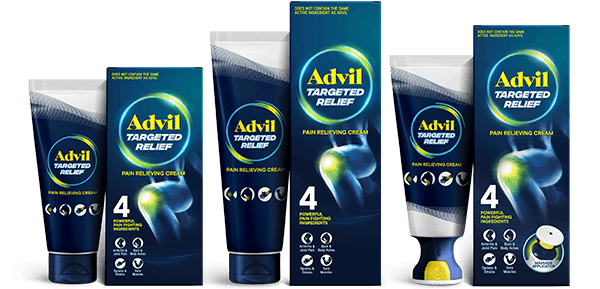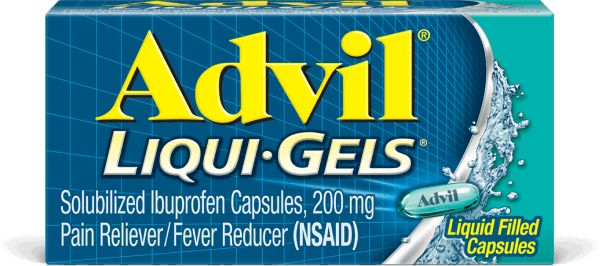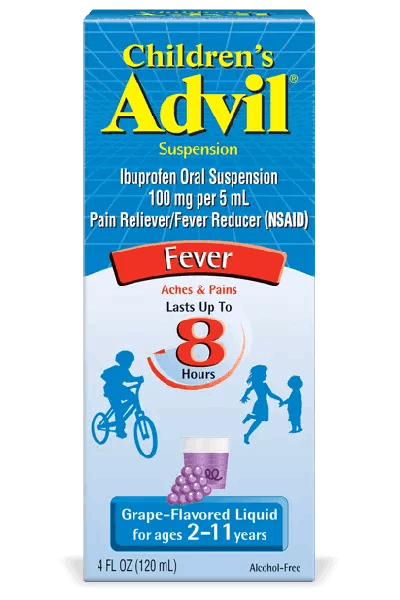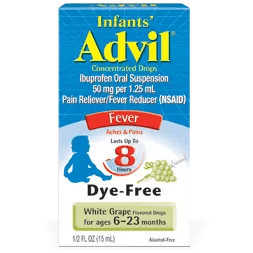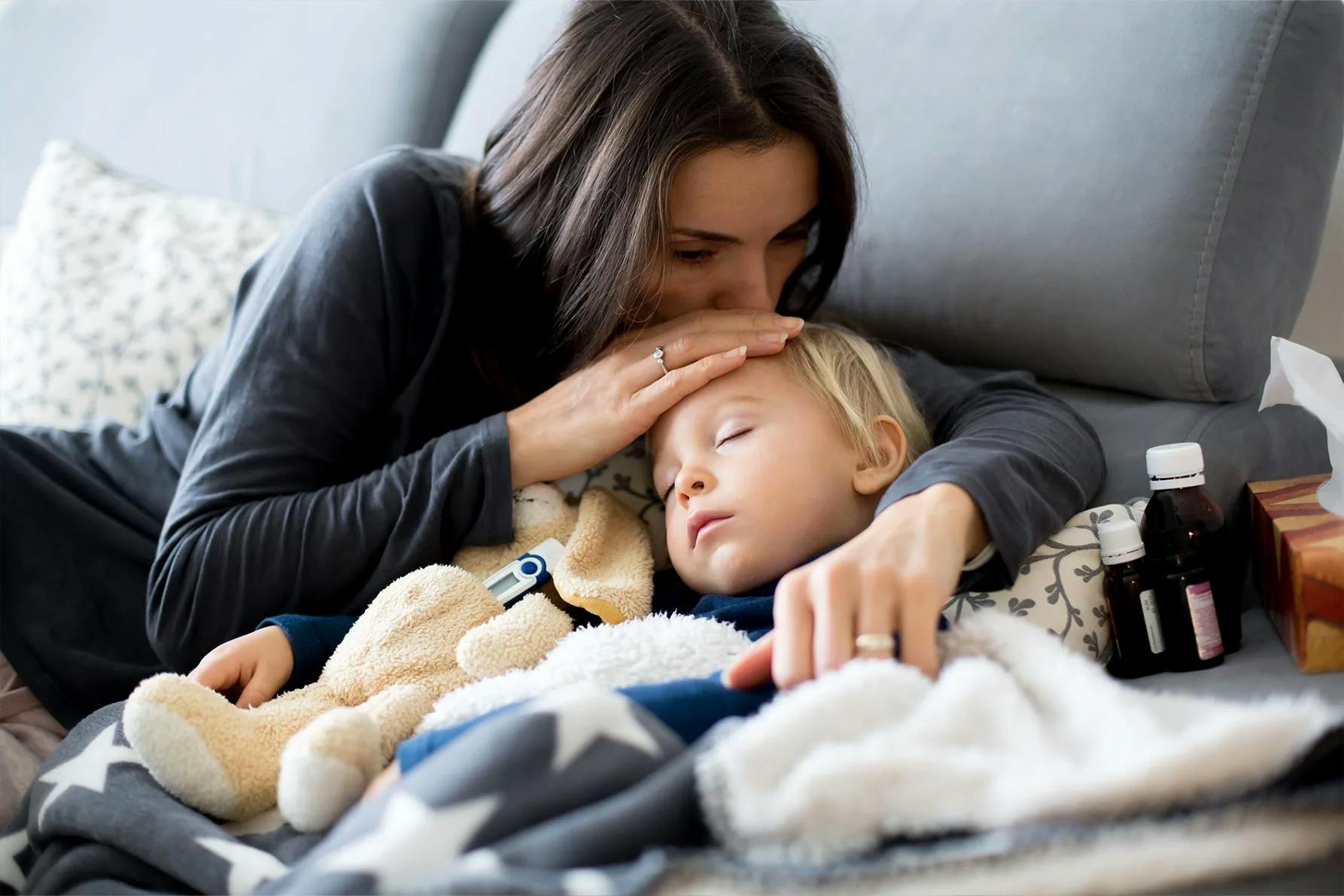Fevers in kids are incredibly common. 1 In most cases, they aren’t cause for alarm. 1 In fact, a fever can be a good sign, showing that a child’s natural defenses are working to combat infection. 2 In some cases, though, like with an infant, a fever should always be taken more seriously. Learn how to recognize a fever in your child, what may cause it, how to help them through it and how to know if you need to seek more help.
What Is a Fever?
Fever occurs when body temperature is abnormally high. 1,2,3,4,5 Our body temperature naturally fluctuates based on several factors, including activity, environment, emotions and even time of day. 1,2,3 The average normal body temperature is 98.6°F, but going a little above or below that is typical. 1,2,3 The normal range is around 97-99°F. 4
This temperature can rise into the feverish range when the body is fighting an infection. 1,3,4 That’s why the presence of a fever, while perhaps not fun for the child who has it, can be a positive sign that their immune system is properly defending against a virus or bacteria. 1,2,3,4
What Causes Fever in Children?
The most common cause of fevers in children are viral infections, such as a cold, RSV or Covid. 4 The second leading cause of fever in kids is a bacterial infection, such as pneumonia or an ear infection. 4 Fevers can also be caused by environmental factors, like room temperature or activity, and some children experience fever for one or two days after immunizations. 3,5
How Do I Know if My Child Has a Fever?
Determining whether a child has a fever can be especially tricky because different types of thermometers provide varying levels of accuracy, with rectal thermometers being the most accurate (though they may not be tolerated after a certain age and some people aren’t comfortable using them). 1,2,3,4,5
Here is a guide for when your child has a fever, based on how you’re taking their temperature: 3
- Rectal thermometer: 100.4°F
- Oral thermometer: 99.5°F
- Under-the-arm thermometer: 99°F
When Should I Be Concerned About My Child’s Fever?
While many fevers don’t warrant concern, here are the signs to look for according to your child’s age: 1
Newborn to Three Months
If your child is an infant under three months of age, any fever is reason to call your doctor. 1,2,3,4,5 Since a newborn’s immune system may not have developed enough to fight off infection, any sign of fever requires medical attention. 1,2,3,4,5
Three Months to One Year Old
In infants three months to one year old, fevers should also be treated with extra care. 1,5 For infants between three months and one year old, seek medical attention if it is over 102.4°F, lasts more than twenty-four hours or is accompanied by any of these signs: 5
- Fever returning after being gone twenty-four hours
- Trouble breathing
- Difficulty swallowing
- Isn’t moving
- Isn’t waking up
- Cries with every touch
- Chills for more than thirty minutes
- Purple or blood-colored spots on the skin
- Signs of dehydration, including no urine for eight hours, very dark urine or little to no spit or tears
- Blue nails, lips or tongue
- Seizure
One Year or Older
For children one year or older, medical attention is required if the fever is over 104°F, lasts more than three days or is accompanied by any of these other symptoms: 1,2,3,4,5
- Listlessness or confusion, with little or no eye contact
- Continuous vomiting
- Severe headache, sore throat, stomachache or discomfort
- A new rash or bruising
- Has blue nails, lips or tongue
- Won’t move one or more limbs
- Pain with urination
- Seizure
- Isn’t able to stop crying
- Fever isn’t coming down with fever reducers
How Do I Treat a Child with a Fever?
Most fevers in children will resolve themselves within a few days, but we can still work to keep children comfortable in the meantime. 1 Here are the dos and don’ts of treating your child’s fever. 1,2,3,4,5
Do
- Encourage your child to rest
- Hydrate, hydrate, hydrate
- For children six months and older, give them acetaminophen or ibuprofen to help reduce fever and relieve discomfort
- Soothe them with a cool compress
- Provide food, if the child is hungry
Don’t
- Place your child in a cold bath, as this can cause the body to shiver, raising the internal temperature
- Turn up the heat or cover your child in heavy blankets
- Give medicine to children six months or younger without guidance from a medical professional
Fevers simply can’t be avoided in children, and they are most often a healthy response to infection. 1,2,3,4 When you need to treat your child’s fever, you can trust Children’s Advil. It reduces fevers faster 6 and longer than Children’s Tylenol. To quickly discover the right medicine for your child, use Advil’s Relief Finder.
Source Citations:
- Fever. Mayo Clinic. https://www.mayoclinic.org/diseases-conditions/fever/symptoms-causes/syc-20352759?p=1. Accessed 03/30/23.
- Kid’s Fevers: When to Worry, When to Relax. Cleveland Clinic. https://health.clevelandclinic.org/kids-fevers-when-to-worry-when-to-relax/
- Fever in Children. National Institute of Health. https://medlineplus.gov/ency/article/003090.htm. Accessed 03/30/23.
- Fevers in adults, children and toddlers: When to worry. Stamford Health. https://www.stamfordhealth.org/healthflash-blog/primary-care/fever-in-adults-when-to-worry/. Accessed 3/31/23.
- Fever (0-12 months). Seattle Children’s. https://www.seattlechildrens.org/conditions/a-z/fever-0-12-months/. Accessed 3/31/23.
- Based on reducing fever below 100°F. Brands herein are trademarks of their respective owners.
